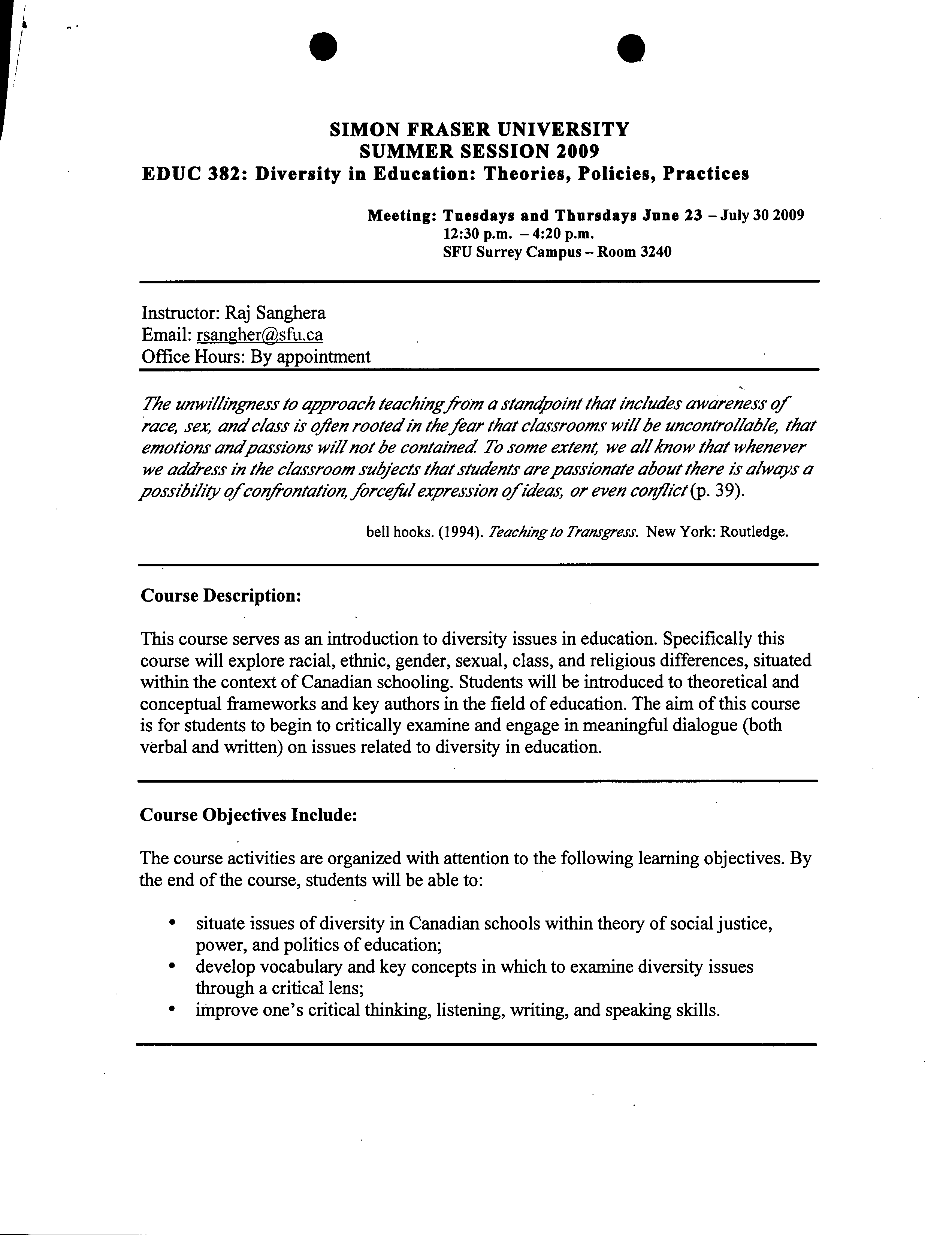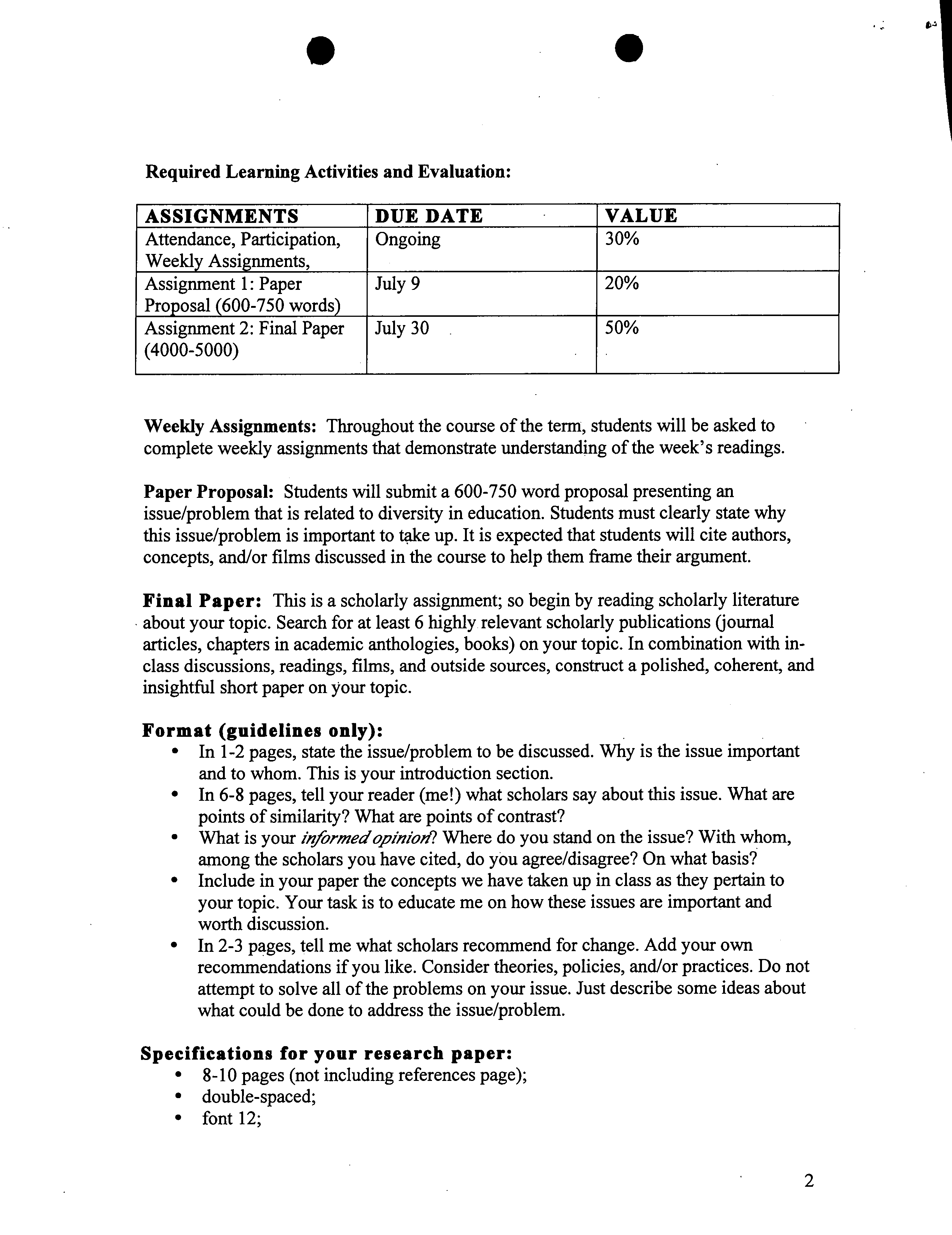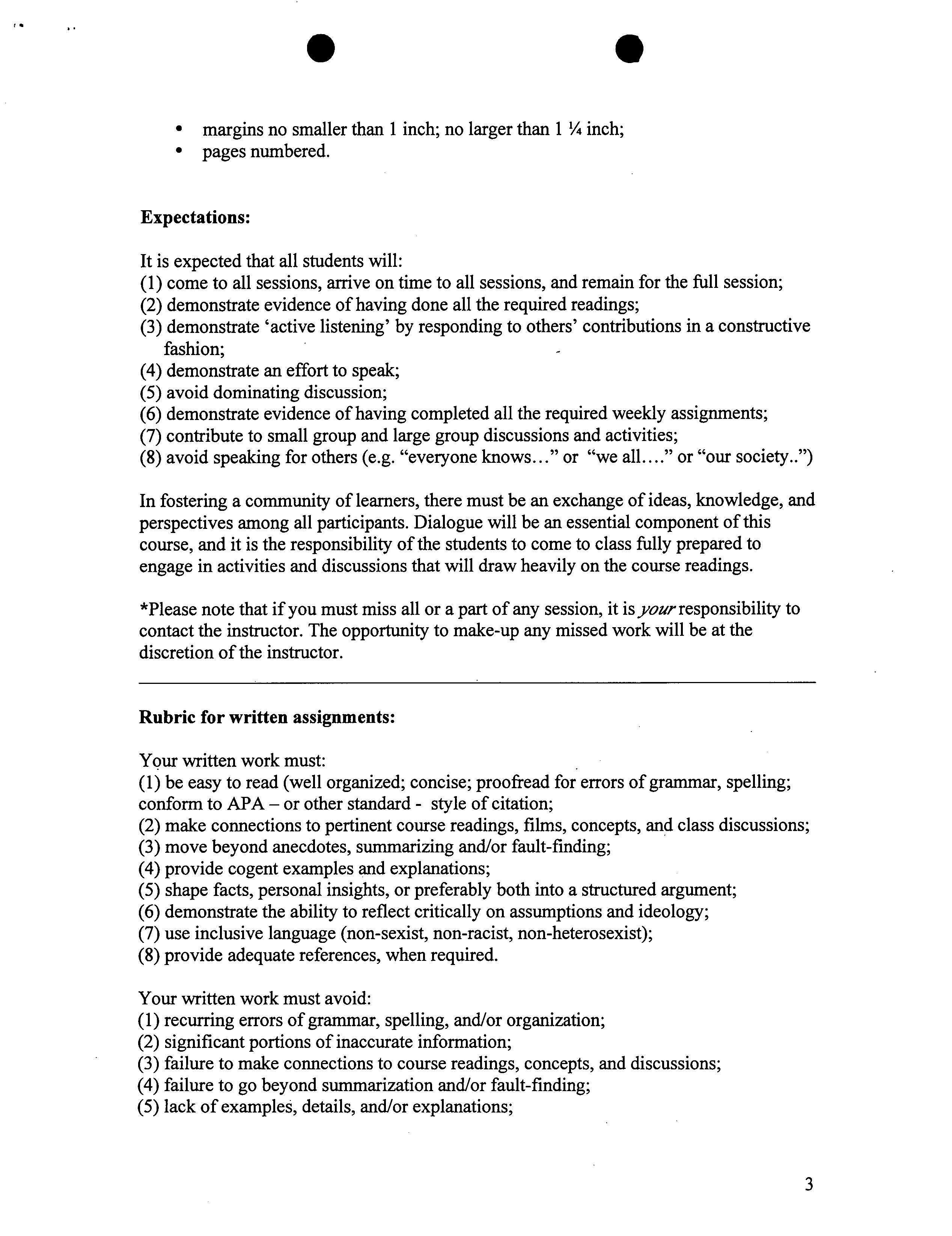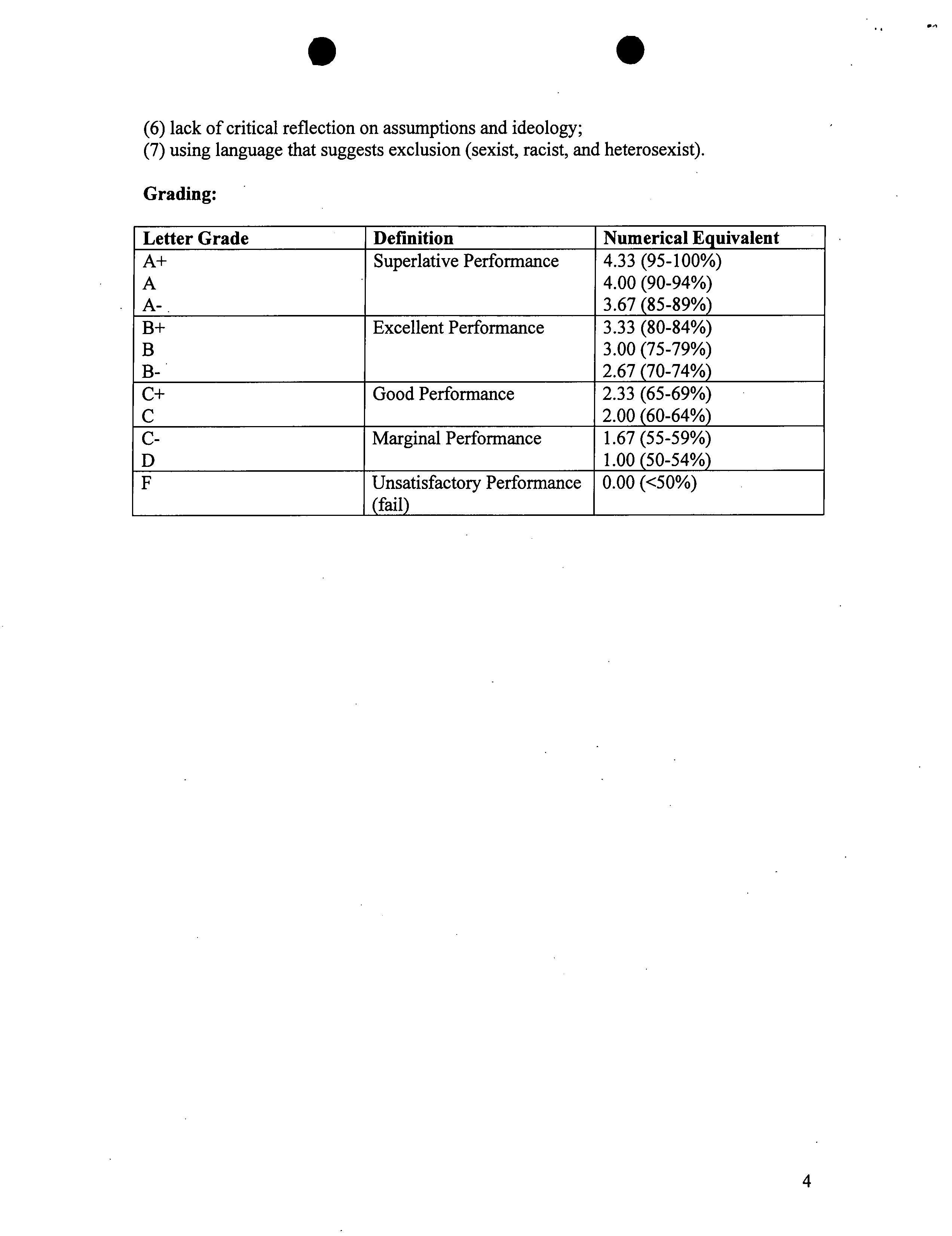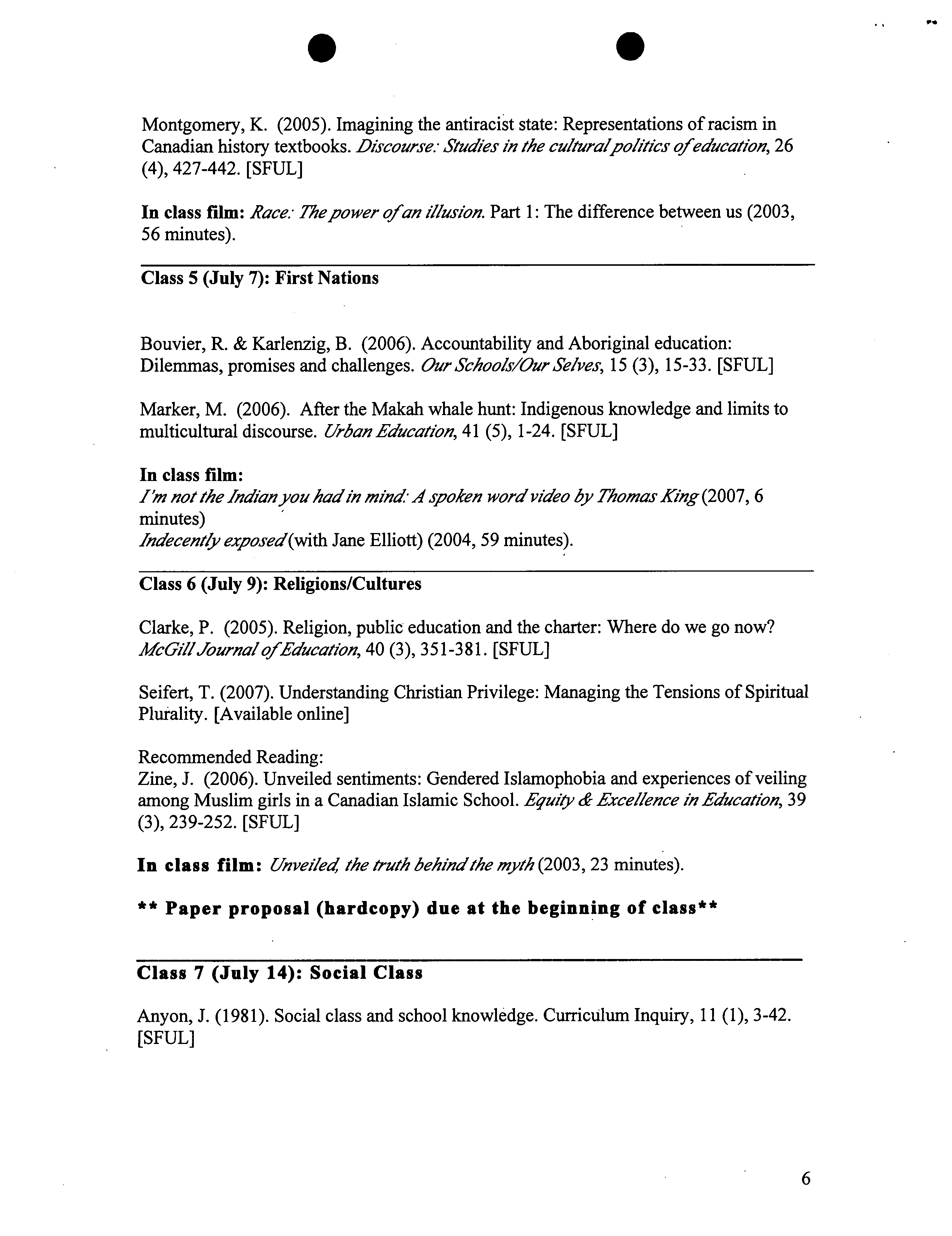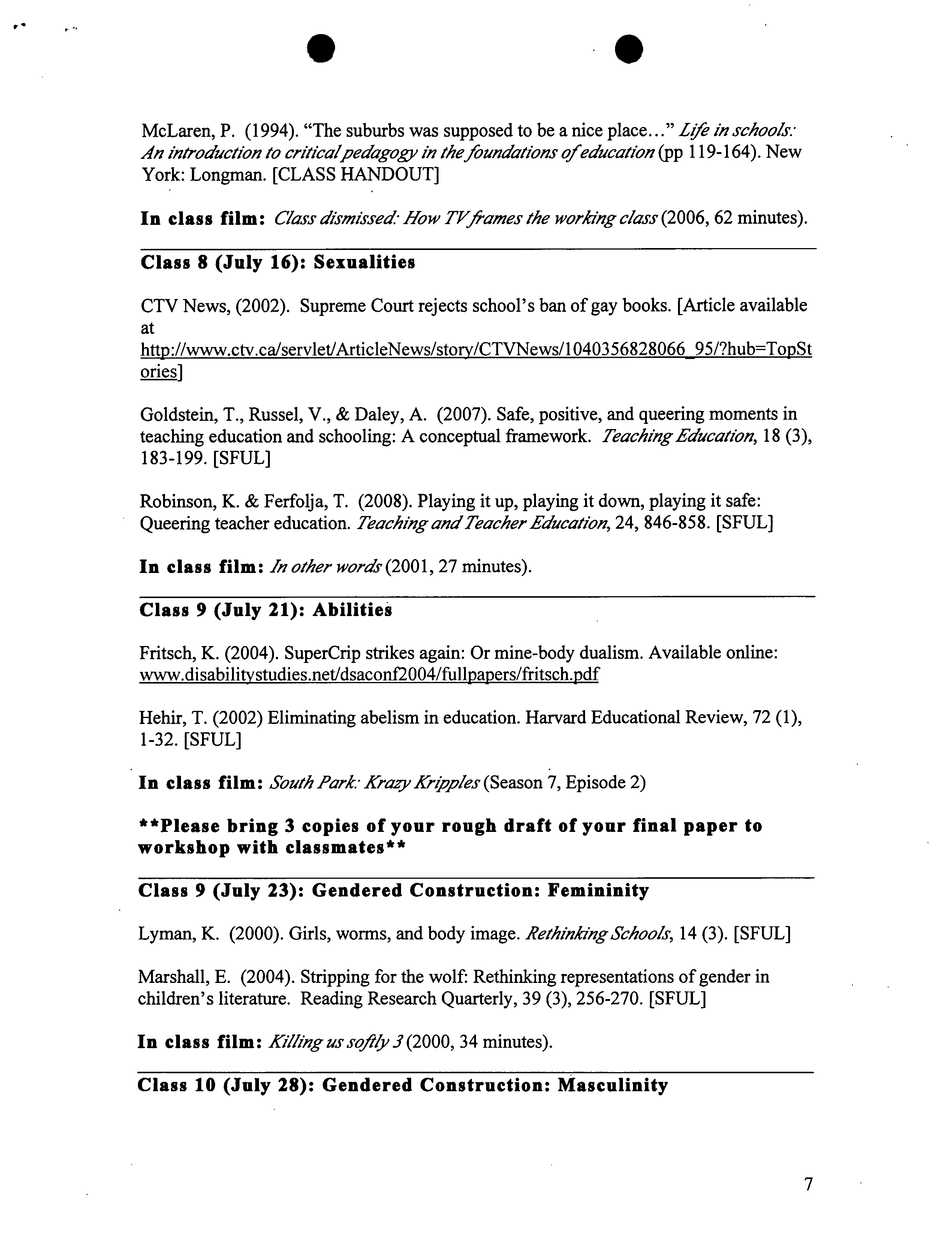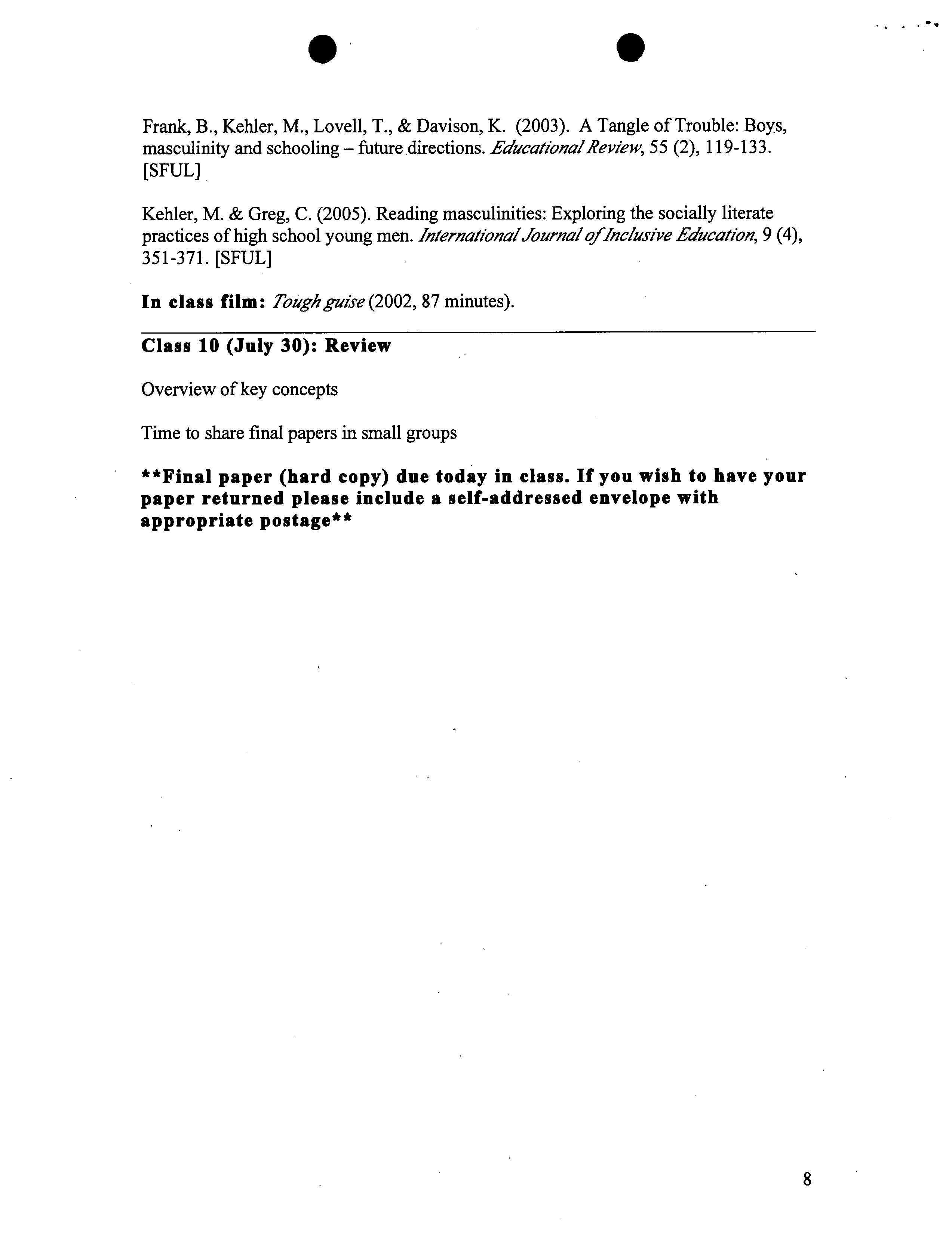.
?
.
SIMON FRASER UNIVERSITY
SUMMER SESSION 2009
EDUC 382: Diversity in Education: Theories, Policies, Practices
Meeting: Tuesdays and Thursdays June 23 - July 30 2009
12:30 p.m. - 4:20 p.m.
SFU Surrey Campus - Room 3240
Instructor: Raj Sanghera
Email: rsanghersfu.ca
Office Hours: By appointment
The unwillingness to approach teaching
from
a stana'oofrzt that includes awareness of
race, sex, and class is often rooted/n thefear that classrooms will be uncontrollable, that
emotions andpassions will not be contained To some extent, we all know that whenever
we address fri the classroom subjects that students are passionate about there is always a
possibility ofconf
r
ontation, forceñd expression
of ideas, or even conflict (p. 39).
bell hooks. (1994).
Teaching to Transgress.
New
York: Routledge.
Course Description:
This course serves as an introduction to diversity issues in education. Specifically this
course will explore racial, ethnic, gender, sexual, class, and religious differences, situated
within the context of Canadian schooling. Students will be introduced to theoretical and
conceptual frameworks and key authors in the field of education. The aim of this course
is for students to begin to critically examine and engage in meaningful dialogue (both
verbal and written) on issues related to diversity in education.
Course Objectives Include:
The course activities are organized with attention to the following learning objectives. By
the end of the course, students will be able to:
situate issues of diversity in Canadian schools within theory of social justice,
power, and politics of education;
develop vocabulary and key concepts in which to examine diversity issues
through a critical lens;
improve one's critical thinking, listening, writing, and speaking skills.
. ?
.
Required Learning Activities and Evaluation:
ASSIGNMENTS
DUE DATE
VALUE
Attendance, Participation,
Ongoing
30%
Weekly Assignments,
Assignment 1: Paper
July 9
20%
Proposal
(600-750
words)
Assignment 2: Final Paper
July 30
50%
(4000-5000)
Weekly Assignments:
Throughout the course of the term, students will be asked to
complete weekly assignments that demonstrate understanding of the week's readings.
Paper Proposal:
Students will submit a 600-750 word proposal presenting an
issue/problem that is related to diversity in education. Students must clearly state why
this issue/problem is important to take up. It is expected that students will cite authors,
concepts, and/or films discussed in the course to help them frame their argument.
Final Paper:
This is a scholarly assignment; so begin by reading scholarly literature
about your topic. Search for at least 6 highly relevant scholarly publications (journal
articles, chapters in academic anthologies, books) on your topic. In combination with in-
class discussions, readings, films, and outside sources, construct a polished, coherent, and
insightful short paper on your topic.
Format (guidelines only):
• In 1-2 pages, state the issue/problem to be discussed. Why is the issue important
and to whom. This is your introduction section.
• In 6-8 pages, tell your reader (me!) what scholars say about this issue. What are
points of similarity? What are points of contrast?
• What is your
/nJbrmedopi>z/on?
Where do you stand on the issue? With whom,
among the scholars you have cited, do you agree/disagree? On what basis?
• Include in your paper the concepts we have taken up in class as they pertain to
your topic. Your task is to educate me on how these issues are important and
worth discussion.
• In 2-3 pages, tell me what scholars recommend for change. Add your own
recommendations if you like. Consider theories, policies, and/or practices. Do not
attempt to solve all of the problems on your issue. Just describe some ideas about
what could be done to address the issue/problem.
Specifications for your research paper:
• 8-10 pages (not including references page);
• double-spaced;
• font 12;
.
?
S
• margins no smaller than 1 inch; no larger than 1
'/4
inch;
• pages numbered.
Expectations:
It is expected that all students will:
(1)
come to all sessions, arrive on time to all sessions, and remain for the full session;
(2)
demonstrate evidence of having done all the required readings;
(3)
demonstrate 'active listening' by responding to others' contributions in a constructive
fashion; ?
-
(4)
demonstrate an effort to speak;
(5)
avoid dominating discussion;
(6)
demonstrate evidence of having completed all the required weekly assignments;
(7)
contribute to small group and large group discussions and activities;
(8)
avoid speaking for others (e.g. "everyone knows..." or "we all...." or "our society..")
In fostering a community of learners, there must be an exchange of ideas, knowledge, and
perspectives among all participants. Dialogue will be an essential component of this
course, and it is the responsibility of the students to come to class fully prepared to
engage in activities and discussions that will draw heavily on the course readings.
*please note that if you must miss all or a part of any session, it is
your
responsibility to
contact the instructor. The opportunity to make-up any missed work will be at the
discretion of the instructor.
Rubric for written assignments:
Your written work must:
(1)
be easy to read (well organized; concise; proofread for errors of grammar, spelling;
conform to APA - or other standard - style of citation;
(2) make connections to pertinent course readings, films, concepts, and class discussions;
(3)
move beyond anecdotes, summarizing and/or fault-finding;
(4) provide cogent examples and explanations;
(5)
shape facts, personal insights, or preferably both into a structured argument;
(6)
demonstrate the ability to reflect critically on assumptions and ideology;
(7)
use inclusive language (non-sexist, non-racist, non-heterosexist);
(8)
provide adequate references, when required.
Your written work must avoid:
(1) recurring errors of grammar, spelling, and/or organization;
(2) significant portions of inaccurate information;
(3) failure to make connections to course readings, concepts, and discussions;
(4)
failure to go beyond summarization and/or fault-finding;
(5) lack of examples, details, and/or explanations;
(6)
lack of critical reflection on assumptions and ideology;
(7)
using language that suggests exclusion (sexist, racist, and heterosexist).
Grading:
Letter Grade
Definition
Numerical Equivalent
A+
Superlative Performance
4.33 (95-100%)
A ?
.
4.00 (90-94%)
A-.
3.67 (85-89%)
B+
Excellent Performance
3.33 (80-84%)
B
3.00
(75-79%)
B- •
2.67 (70-74%)
C+
Good Performance
2.33
(65-69%)
C
2.00 (60-64%)
C-
Marginal Performance
1.67
(55-59%)
D
1.00
(50-54%)
F
Unsatisfactory Performance
0.00 (<50%)
(fail)
_______
S ?
S
WEEKLY TOPICS AND READINGS
SFUL = article available through SFU Libraries online databases
Class 1 (June 23): Welcome! Introduction to Diversity in Education
DiAngelo, R. & Sensoy,
O.
(in press, 2009). We don't want your opinion: Knowledge
construction and the discourse of opinion on the equity classroom.
Equity & Excellence
in Education,
42 (4).
In class film:
Pride and prejudice: The road to human rights and multiculturalism in
BC (1999, 60 minutes).
Class 2 (June 25): Oppression/Agency
Kivel, P. (2002). The culture of power. Available online: www.paulidvel.com
Young, I.M. (1999). The five faces of oppression. Available online:
http://www.racialeguitytools.org/resourcefiles/young.pdf
In class film:
The color ofFear(1994,
90 minutes).
Class 3 (June 30): Representation
Hall, S. (1997). Chapter 1, Representation, meaning and language. In S. Hall (Ed.).
Jepresentation: Cultural representations andsiçni5'/ngpractices
(pp
15-29).
London: Sage Publications. [CLASS HANDOUT]
Meek, B. (2006). And the injun goes "how:" Representations of American Indian English
in white public space.
Language in Society, 35 (1),
93-128. [Available SFUL]
Provenzo, Jr., E. & Kincheloe, J.L. (1996).
klediaandschools: What i1c the effect of
kiedia on the educational experiences ofchildren? (pp
2
15 -23 6).
New York: Peter
Lang. [CLASS HANDOUT]
In class film:
bell hooks: Cultural criticism
c
transformation
(1997,
55
minutes).
Class 4 (July 2): Race
Lund, E. (2006). Rocking the racism boat: School-based activists speak out on
denial and avoidance.
Race Ethnicfty andEducation,
9 (2), 203-221. [SFUL]
5
S ?
S
Montgomery, K. (2005). Imagining the antiracist state: Representations of racism in
Canadian history textbooks. D.&course: Studies in the culturalpo/frics a/education,
26
(4),427-442. [SFUL]
In class film:
Race.- T he power 0/an illusion.
Part 1: The difference between us (2003,
56
minutes).
Class 5 (July 7): First Nations
Bouvier, R. & Karlenzig, B. (2006). Accountability and Aboriginal education:
Dilemmas, promises and challenges.
Our Schools/Our Selves, 15 (3),
15-33. [SFUL]
Marker, M. (2006). After the Makah whale hunt: Indigenous knowledge and limits to
multicultural discourse.
Urban Education,
41(5), 1-24. [SFUL]
In class film:
I'm no/the Indian you hadi>z mind A spoken word video by Thomas King
(2007, 6
minutes)
Indecently exposed(with
Jane Elliott) (2004,
59
minutes).
Class 6 (July 9): Religions/Cultures
Clarke, P.
(2005).
Religion, public education and the charter: Where do we go now?
McGill Journal o/Education,
40 (3), 351-381. [SFUL]
Seifert, T. (2007). Understanding Christian Privilege: Managing the Tensions of Spiritual
Plurality. [Available online]
Recommended Reading:
Zine, J. (2006). Unveiled sentiments: Gendered Islamophobia and experiences of veiling
among Muslim girls in a Canadian Islamic School.
Equity f Excellence ,>zEducation,
39
(3), 239-252. [SFUL]
In class film:
Unveiled, the truth behindthe myth
(2003, 23 minutes).
** Paper proposal (hardcopy) due at the beginning of class**
Class 7 (July 14): Social Class
Anyon, J. (1981). Social class and school knowledge. Curriculum Inquiry, 11(1), 3-42.
[SFUL]
S
McLaren, P. (1994). "The suburbs was supposed to be a nice place..."
L(/è
In schools:
14n
,ztroduction to cr11/ca/pedagogy in thefoundat/ons ofeducatlon (
pp 119-164). New
York: Longman. [CLASS HANDOUT]
In class film:
Class dismissed- how
TJ'frames
the working class
(2006, 62 minutes).
Class 8 (July 16): Sexualities
CTV News, (2002). Supreme Court rejects school's ban
of gay
books. [Article available
http ://www.ctv.calservletlArticleNews/stor y
/CTVNews/l 0403 56828066_95/?hubTopSt
ones]
Goldstein, 1., Russel, V., & Daley, A. (2007). Safe, positive, and queering moments in
teaching education and schooling: A conceptual framework.
Teaching Education,
18 (3),
183-199. [SFUL]
Robinson, K. & Ferfoija, T. (2008). Playing it up, playing it down, playing it safe:
Queering teacher education.
Teaching and Teacher Education,
24, 846-858. [SFUL]
In class film:
In other words (2001, 27 minutes).
Class 9 (July 21): Abilities
Fritsch, K. (2004). SuperCrip strikes again: Or mine-body dualism. Available online:
www.disabilitystudies.netldsaconf2004/fullpai,ers/fritsch.pdf
Hehir, T. (2002) Eliminating abelism in education. Harvard Educational Review, 72 (1),
1-32. [SFUL]
In class film:
South Park: Krazy Kr (pp/es
(Season 7, Episode 2)
**please bring 3 copies of your rough draft of your final paper to
workshop with classmates**
Class 9 (July 23): Gendered Construction: Femininity
Lyman, K. (2000). Girls, worms, and body image.
Rethinking
Schools,
14 (3). [SFUL]
Marshall, E. (2004). Stripping for the wolf: Rethinking representations of gender in
children's literature. Reading Research Quarterly, 39 (3), 256-270. [SFUL]
In class film:
Kil/thgussoft/y3(2000,
34 minutes).
Class 10 (July 28): Gendered Construction: Masculinity
p.
7
.
?
.
Frank, B., Kehler, M., Love!!, T., & Davison, K. (2003). A Tangle of Trouble: Boys,
masculinity and schooling - future directions.
Educational Jeview, 55 (2),
119-133.
[SFUL]
Kehler, M. & Greg, C. (2005). Reading masculinities: Exploring the socially !iterate
practices of
high school young men.
Internat/ona/Jozirnaloflnclusive Education,
9 (4),
351-371.
[SFUL]
In class film:
lbughguice (2002,
87 minutes).
Class 10 (July 30): Review
Overview of key concepts
Time to share final papers in small groups
**Final paper (hard copy) due today in class. If you wish to have your
paper returned please include a self-addressed envelope with
appropriate postage**
8
